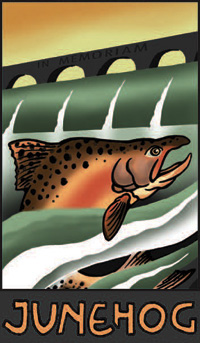 Before Harry Potter book signing parties, there were other parties, wine parties, that came more frequently than those of the Harry Potter variety. They came every 3rd Thursday in November to be precise. And the tradition lives on....
Just one week before Thanksgiving stacks of the colorful Georges Duboeuf's famous Beaujolais Nouveau are sent out to wine shops from Beaujolais, France (think Southern Burgundy where Pinot Noir thrives). Wondered what it is? Beaujolais is a wine made from a grape called Gamay. The Nouveau style is made through a fermentation process called carbonic maceration and is released super-duper fresh, i.e. from harvest to bottle to market within mere weeks! It is intended consumers drink this wine young, and certainly no longer than 6 months. Why? Well, Gamay is a low-tannin varietal, which makes it optimal for those who prefer a light-styled, fruity, fruity wine. But even with it's naturally high acidity (another "age-worthy" component for wine), the fact that the wine goes through carbonic maceration hurts the wine's natural ability to age.
Before Harry Potter book signing parties, there were other parties, wine parties, that came more frequently than those of the Harry Potter variety. They came every 3rd Thursday in November to be precise. And the tradition lives on....
Just one week before Thanksgiving stacks of the colorful Georges Duboeuf's famous Beaujolais Nouveau are sent out to wine shops from Beaujolais, France (think Southern Burgundy where Pinot Noir thrives). Wondered what it is? Beaujolais is a wine made from a grape called Gamay. The Nouveau style is made through a fermentation process called carbonic maceration and is released super-duper fresh, i.e. from harvest to bottle to market within mere weeks! It is intended consumers drink this wine young, and certainly no longer than 6 months. Why? Well, Gamay is a low-tannin varietal, which makes it optimal for those who prefer a light-styled, fruity, fruity wine. But even with it's naturally high acidity (another "age-worthy" component for wine), the fact that the wine goes through carbonic maceration hurts the wine's natural ability to age.
The hoopla of this catch-and-release process began in the late 1800s. Locals recognized this light-styled red wine was perfect for the transition between seasons and the unofficial 'switch' from white to red wine drinking - and they made a party of it (just imagine! pitchers of wine from the barrels were on offer!!) while the more grand Beaujolais wines were still working their mojo and evolving. The French government decided to reign in the revelry a little bit in 1938 and then in 1951 declared the "3rd Thursday in November" rule.
I don't mean to mislead you, however. Georges Duboeuf isn't the only producer of Beauojolais Nouveau; he's just the most famous because he produces so much of the stuff. Regardless who's Nouveau you select to sip, expect tooty-fruity red berry flavors. It's not my bag, though I have come to appreciate Beaujolais/Gamay when on offer from one of the premiere villages where the wine hasn't been quite as fast-tracked, e.g. Moulin-a-Vent, Morgon, Fleurie and Brouilly. Those wines tend to offer a bit more complexity - a touch of earth, a touch more depth, and a touch of tannin to offset all of that boisterous fruit! Their light style, much like Pinot Noir, is indeed a great complement to your turkey dinner.
So the question is... will you Nouveau?


 A few weeks ago I stumbled upon a rare treat in the larger wine world, particularly here in North America: Pineau des Charentes. When I saw that
A few weeks ago I stumbled upon a rare treat in the larger wine world, particularly here in North America: Pineau des Charentes. When I saw that  Stumbled across a wine lately that sang a familiar tune but offered s o m u c h m o r e than the same old same old?
I find this happens when I least expect it - and often enough when the grapes involved in the winemaking process are local, or native to the area from whence they're grown. We talked about
Stumbled across a wine lately that sang a familiar tune but offered s o m u c h m o r e than the same old same old?
I find this happens when I least expect it - and often enough when the grapes involved in the winemaking process are local, or native to the area from whence they're grown. We talked about  White wines aren't just a summer thang. (One of the best turkey wines is actually
White wines aren't just a summer thang. (One of the best turkey wines is actually  Today the rain and leaves are swirling and the sun isn't due to show itself. On burly fall days like these, there's nothing better than an awesome bottle of wine to hunker down with and lift your spirits!
The last few weeks I've broken down the nerdier nuances of cool red varietals perfect for fall. While fabulous on their own, sometimes the best of the best are actually blends of a few - or several - different grapes. Given the circumstances outside my office window, it's only appropriate that we start exploring these finds with the 2005 SNAFU red blend.
Today the rain and leaves are swirling and the sun isn't due to show itself. On burly fall days like these, there's nothing better than an awesome bottle of wine to hunker down with and lift your spirits!
The last few weeks I've broken down the nerdier nuances of cool red varietals perfect for fall. While fabulous on their own, sometimes the best of the best are actually blends of a few - or several - different grapes. Given the circumstances outside my office window, it's only appropriate that we start exploring these finds with the 2005 SNAFU red blend. I spend a lot of time in the shop hanging out in our Argentine/Spanish section. Not only do our customers gravitate to that area, but I found my first bottle of love from a non-US producer in that aisle: (Altos de las Hormigas) Malbec.
I was hesitant to talk about
I spend a lot of time in the shop hanging out in our Argentine/Spanish section. Not only do our customers gravitate to that area, but I found my first bottle of love from a non-US producer in that aisle: (Altos de las Hormigas) Malbec.
I was hesitant to talk about  Once again I find myself scribing another
Once again I find myself scribing another  What better way to continue our discussion about wines perfect for fall than to start the month of October with some banter about a monster wine? Petite Sirah (note the "i" in Sirah) is also a stealthy little operator, or the masked creature standing on your front steps in just 30 days time. Boo-ha-ha-ha-ha-ha!!!
"What the heck is she getting at today," you ask with incredible anticipation and a smile dancing at the corners of your mouth?
What better way to continue our discussion about wines perfect for fall than to start the month of October with some banter about a monster wine? Petite Sirah (note the "i" in Sirah) is also a stealthy little operator, or the masked creature standing on your front steps in just 30 days time. Boo-ha-ha-ha-ha-ha!!!
"What the heck is she getting at today," you ask with incredible anticipation and a smile dancing at the corners of your mouth? Now that it is fall again and I see kids heading off to school clearly trying to fit in while being their own person, I'm reminded there are some fun varietals out there that don't always get the attention they deserve. And there are some perfect ones for this time of year! Let's take a closer look...
Now that it is fall again and I see kids heading off to school clearly trying to fit in while being their own person, I'm reminded there are some fun varietals out there that don't always get the attention they deserve. And there are some perfect ones for this time of year! Let's take a closer look...
 Wine Blogging Wednesday
Wine Blogging Wednesday